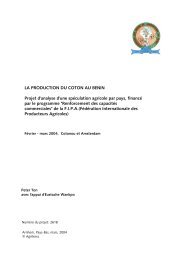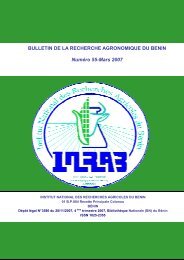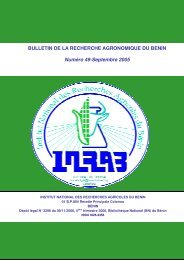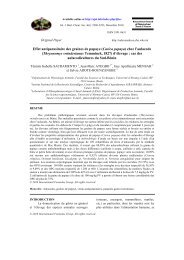Bulletin <strong>de</strong> la Recherche Agronomique du Bénin Numéro 69 – Juin 2011the diversification of their activities. The study showed that 67% of the affected h<strong>ou</strong>seholds haddiversified their income-generating activities. One activity gaining importance in their eyes waslivestock production, mainly goats, grasscutter and p<strong>ou</strong>ltry production.Table 5. Average income of h<strong>ou</strong>seholds during pre-affection periodAffected H<strong>ou</strong>seholds Non-Affected H<strong>ou</strong>seholdsAverage income (Fcfa) 463 000 461 000t 0.018Probabilité of t (p) 0.985Table 6. Average income of h<strong>ou</strong>seholds during affection periodAffected H<strong>ou</strong>seholds Non-Affected H<strong>ou</strong>seholdsAverage income (Fcfa) 312 000 480 000t -3.446Probability of t (p) 0.001During the pre-affection period, the two gr<strong>ou</strong>ps had similar shares of income generated by livestockproduction in the total income (p > 0.1) (Table 7). But during the affection period, the shares of thelivestock production in their total income are different at 10% significance level (Table 8).Table 7. Average income of h<strong>ou</strong>seholds during pre-affection periodAffected H<strong>ou</strong>seholds Non-Affected H<strong>ou</strong>seholdsAverage income (Fcfa) 10.56% 12.83%t -1.148Probabilité of t (p) 0.253Table 8. Average income of h<strong>ou</strong>seholds during affection periodAffected H<strong>ou</strong>seholds Non-Affected H<strong>ou</strong>seholdsAverage income (Fcfa) 21.12% 15.9%t 1.611Probability of t (p) 0.10Adjustments operated on “Farm Land”The study showed that 8.6% of the affected h<strong>ou</strong>seholds sold farm land during the last five years.During the same period, only 2.8% of the non-affected h<strong>ou</strong>seholds sold farm land. The sale of farmland by the affected h<strong>ou</strong>seholds can be seen as a coping strategy <strong>de</strong>veloped in or<strong>de</strong>r to meet healthcare expenses related to HIV/AIDS. With regard to the land tenure status, in the affection period, theproportion of affected h<strong>ou</strong>seholds borrowing land is almost three times greater than the one duringpre-affection period (Tables 9 and 10). Conversely, the proportion of this gr<strong>ou</strong>p of h<strong>ou</strong>seholds holdinginherited land, purchased land and leased land became lower. Consi<strong>de</strong>ring the non-affectedh<strong>ou</strong>seholds, the ten<strong>de</strong>ncy with regard to the land tenure status did not really change from the preaffectionperiod to the affection period. From these results, it was inferred that after the sale of theirlands, the affected h<strong>ou</strong>seholds referred to parents and friends to borrow farm land. This was also akind of strategy they <strong>de</strong>veloped to cope with the effects of the pan<strong>de</strong>mic.Table 9. Proportion of affected h<strong>ou</strong>seholds with regard to the land tenure statusLand tenure status Pre-affection period Affection periodInheritance 81% 78%Purchase 25% 21%Lease 26% 21%Gift 10% 12%Borrow 5% 13%32
Bulletin <strong>de</strong> la Recherche Agronomique du Bénin Numéro 69 – Juin 2011Table 10. Proportion of non-affected h<strong>ou</strong>seholds with regard to the land tenure statusLand tenure status Pre-affection period Affection periodInheritance 88% 88%Purchase 27% 30%Lease 21% 22%Gift 12% 14%Borrow 6% 6%Adjustments on the farming practicesThe focus gr<strong>ou</strong>p discussions showed that both affected and non-affected h<strong>ou</strong>seholds br<strong>ou</strong>ght vari<strong>ou</strong>sadjustments to their farming systems. These adjustments inclu<strong>de</strong>d the abandonment of the slash andburn practice, the frequent use of rotation between cereals and legumin<strong>ou</strong>s plants, and the regular useof manure to improve soil fertility. To mitigate the drop of soil fertility, some farmers increased theseedlings spacing, in or<strong>de</strong>r to increase the sunstroke and the ventilation in the field. Conversely, otherh<strong>ou</strong>seholds increased seedlings <strong>de</strong>nsity. These h<strong>ou</strong>seholds, by doing so, hope to have at least someharvest whatever the risks and the hazards that might occur. Concerning the agricultural calendar, thesurveyed h<strong>ou</strong>seholds explained that they did not have a typical calendar anymore, because of theclimate change effects. So, they have to adapt permanently their farm activities to the context. Forinstance, as there was no more a predictable time for the beginning of the raining season, farmh<strong>ou</strong>seholds used to prepare several times their farms, in or<strong>de</strong>r to be ready anytime the rainfall starts.In addition to the changes listed above, it was noted that some affected h<strong>ou</strong>seholds practicing directsowing, instead of using hoes to make the holes, <strong>de</strong>alt with simple stakes, in or<strong>de</strong>r to reduce thepainfulness of the sowing.DISCUSSIONAmong the adjustments ma<strong>de</strong> by the affected h<strong>ou</strong>seholds, it was noted that an increasing number ofy<strong>ou</strong>ng people and children taking adult responsibilities with regard to their involvement in farmactivities. However, this adjustment is not really effective. In<strong>de</strong>ed, on the first hand, these y<strong>ou</strong>ngpeople and children do not have all the required physical force and the required knowledge to lead thevari<strong>ou</strong>s operations in an optimal way (CVG, 2004). On the second hand, the shift of adults from farmactivities creates a break in the transmission of knowledge to y<strong>ou</strong>ng people and children. This impliesthe erosion of farming knowledge (Loevinsohn and Gillespie, 2003). Moreover, Umeha et al. (2001)apprehend that the reorganization of the work within the farm c<strong>ou</strong>ld be a s<strong>ou</strong>rce of inefficiency,because inexperienced y<strong>ou</strong>ng people are implied more and more in the agricultural activities.To compensate for the loss of family labor, the affected h<strong>ou</strong>seholds hire more labor. Such adjustmentwas also f<strong>ou</strong>nd by Slater and Wiggins (2005). But, as they noticed, this strategy is not sustainable.In<strong>de</strong>ed, to hire en<strong>ou</strong>gh labor, h<strong>ou</strong>seholds need substantial income. But, as most of the affectedh<strong>ou</strong>seholds are low-income h<strong>ou</strong>seholds, they can just hire few paid laborers and this cannot beconsi<strong>de</strong>red as an efficient adjustment.This study also showed that affected h<strong>ou</strong>seholds preferred home gar<strong>de</strong>ns to distant farms. Akrofi(2008) also noticed the same adjustment with Ghanaian HIV-affected h<strong>ou</strong>seholds and he observedthat when these home gar<strong>de</strong>ns are <strong>de</strong>voted to legumes, they can help the affected h<strong>ou</strong>seholds toenhance their nutritional status and income. He ad<strong>de</strong>d that this adjustment is suitable for femalehea<strong>de</strong>dh<strong>ou</strong>seholds. The first reason was that home gar<strong>de</strong>ns require small area. In addition, in thecase of female-hea<strong>de</strong>d h<strong>ou</strong>seholds, after the <strong>de</strong>cease of the husband, the widow generally hasdifficult access to land (Müller, 2004). The second reason was that men are mostly involved in cashcrops growing, while women <strong>de</strong>vote much time for subsistence food and home gar<strong>de</strong>ns (Asfaw, 2002;Trinh et al., 2003). Also, after the loss of male labor, female-hea<strong>de</strong>d h<strong>ou</strong>seholds with home gar<strong>de</strong>nscan <strong>de</strong>al with their scarce res<strong>ou</strong>rces. However, this strategy, in or<strong>de</strong>r to be efficient and sustainablerequires large am<strong>ou</strong>nts of manure and fertilizers. In<strong>de</strong>ed, as home gar<strong>de</strong>ns are located close toh<strong>ou</strong>ses and are continu<strong>ou</strong>sly exploited, they quickly become exhausted.With regard to the sale of farm lands, Bia<strong>ou</strong> (1993) indicated that some h<strong>ou</strong>seholds in S<strong>ou</strong>th-WestBenin come to this option in or<strong>de</strong>r to mitigate financial problems. But, when the sale of farm landoccurs with vulnerable and poor h<strong>ou</strong>seholds, it implies an increase in the number of “landless people”.As mentioned by Nguthi (2008), this is also the case of Kenyan AIDS-affected h<strong>ou</strong>seholds. Theseh<strong>ou</strong>seholds often selld their farm land in the early moments when the infected member was sufferingfrom HIV/AIDS related diseases. Then, the h<strong>ou</strong>sehold’s availability of farm land <strong>de</strong>creases and to33
















